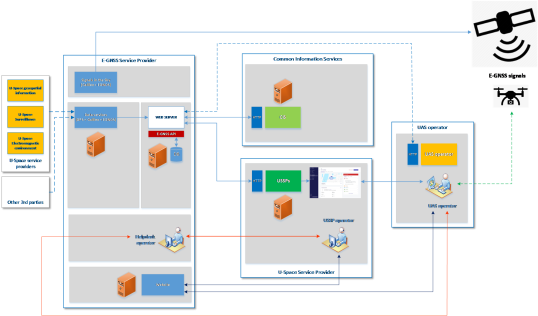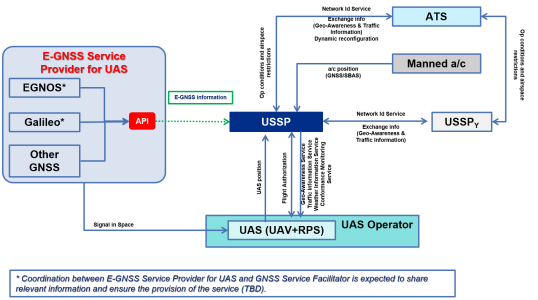Details
- Status
- Closed
- Publication date
- Deadline date
Description
European GNSS Service for Unmanned Aviation - EUGENE
The objective of EUGENE project was to support the European Commission in achieving its objectives to develop a EGNSS (i.e., EGNOS and Galileo) Service for the Unmanned Aviation, in particular to enable medium risk operations requiring a high-performant navigation service and in support of other services in the U-Space ecosystem.
Contract Number: Call for Tenders Reference No DEFIS/2021/OP/0007
Project Segment: Horizon 2020, EGNOS Mission and Services evolution
Duration: 9 months (January 2022 – October 2022)
Budget: €350 000
Project Partners: GMV (Spain), ESSP (France), VVA (Belgium), Unifly (Belgium)
Project Coordinator:
Luis Javier Álvarez Antón
European Commission Project Manager:
Ignacio Alcantarilla
Ignacio.ALCANTARILLA-MEDINA@ec.europa.eu
Background
The Space Strategy for Europe adopted by EC in October 2016 stated that the space sector needed to be better connected to European Union (EU) policies and economic areas and called for the potential of EU space programmes to be better exploited. It particularly requested the European Commission to promote the uptake of European GNSS solutions (i.e. EGNOS and Galileo) in EU policies, where justified and beneficial by taking concrete measures, including regulatory ones. In parallel, and considering aviation as one of the first policies where EGNSS have a positive impact, the European Commission has further worked on concrete actions to promote the uptake of EGNOS and Galileo in five aviation segments, being one of them Unmanned Aerial Systems (UAS).
These actions have addressed different aspects of the drone segment ranging from operations, standardization, receivers or specific applications which benefit from EGNSS world first-class positioning and timing services. In parallel, and leveraging the outcomes of these activities, the European Commission together with EUSPA have outlined a Roadmap for the development of a EGNSS Service for UAS.
Project objectives
The aim of EUGENE project was to support the development of a EGNSS (i.e. EGNOS and Galileo) Service for the Unmanned Aviation, in particular to enable medium risk operations requiring a high-performant navigation service, but also in support of other U-Space services requirement PNT (Position, Navigation and Timing) information. More specifically the project has conducted:
- Identification of service requirements.
- Assessment of the impact on the service provision, including operations.
- Definition of the approach for the user segment.
- Definition of a service provision model level and liability scheme.
- A Cost-Benefit Analysis (CBA) to support a future decision-making process on service implementation and declaration.
- Preparation of a preliminary implementation plan.
Results
The project has identified a set of user needs for the proposed new EGNSS Service, taking into account the project assumption that no evolution of the EGNSS system other than what is currently planned at the program level (e.g. HAS, OSNMA, DFMC EGNOS) can be proposed. It is worth noting that the users considered are the UAS Operators, U-Space Service Providers (USSPs) and the Common Information Service providers (CISs).
Afterwards, the project has defined the requirements of the new EGNSS Service that would be able to meet those user needs. As a matter of fact, four different EGNSS sub-services (each with its own requirements) have been identified in the high-level architecture of the service, and are depicted in the figure below:
- The EGNSS Signa-in-Space that feeds EGNSS approved receivers, including different navigation modes using OS and SoL services according to the needs of the specific UAS missions.
- A EGNSS data service, which provides specific EGNSS pieces of information through an Application Programming Interface (API) to stakeholders (UAS operators, USSPs, CISs).
- A EGNSS website, which allows human operators of USSP, CIS and UAS operators to search for documents and past, current, or forecasted information pertaining to the EGNSS service.
- A EGNSS help desk, which allows the interaction between human staff of the EGNSS Service Provider and human operators of USSP, CIS and UAS operators.
EGNSS service high-level architecture
The main proposed EGNSS sub-service is the data service, which consists of several functions that collect external data (e.g. terrain and obstacles models, GNSS almanacs and outages, measured positioning performances, location of detected RFIs) to feed the EGNSS API, which stores temporarily the data to make it accessible to the stakeholders that request it.
In terms of receiver approach, considering the current regulatory requirements for SAIL III and IV operations, two different standardization and approval options for the on-board EGNSS receiver have been proposed for medium risk operations and for each kind of operations. The proposal is consistent with the current UAS market development, the current regulations in force and the principle of proportionality considering the intrinsic operation risk.
The service provision model for the EGNSS Service for UAS has been developed with the aim of supporting UAS operations within and outside U-Space and also the existing and future U-Space requiring PNT information. A new organization, identified as the “EGNSS Service Provider for UAS”, would be responsible for providing the EGNSS Service to UAS operators, covering the responsibility of the provision of the EGNSS Signal in Space (SiS) to the UAS, the interface to receive the EGNSS performance and monitoring (EGNSS API), EGNSS website and helpdesk to ease the communications with the users of the service.
The model for operations within U-Space airspace is depicted below, showing the interfaces between the different actors in U-Space recognised in regulation 2021/664. USSPs would use the EGNSS information for all U-Space services provided to UAS operators in which it is considered of added value.
EGNSS service provision model within U-Space airspace
Similarly, a service provision model for operations outside U-Space airspace has been proposed.
Based on the proposal of the service provision scheme of the EGNSS Service for UAS, the following elements of the liability scheme have been identified for operations within U-Space airspace:
- New SDD for the EGNSS Service for UAS, comprising the description of the service, way to access the service and terms and conditions of use.
- Service level agreement between Galileo Operator / EGNOS Service Provider with the EGNSS Service Provider for UAS.
- Service level agreement between EGNSS Service Provider and USSP (reference to new SDD to be included within this agreement).
- Contract between UAS operator and USSP (reference to new SDD and service level agreement between EGNSS Service Provider for UAS and the USSP to be included within the contract).
- UAS shall be equipped with an “approved” EGNSS receiver equipment.
The liability scheme outside U-Space airspace consists in the same above elements in order to implement a harmonized approach for all operations.
The performed Cost-Benefit Analysis led to conclude that the investment in the EGNSS service and the development of standards would bring very high net benefits to all the stakeholders directly involved and to the society as a whole. The main cost drivers are the yearly manpower needed by operators for the application of the operational procedures over the analysed period and the costs of adapting the drones. When it comes to the approval options, the main costs are related to developing the EGNSS receivers itself. The main drivers behind the benefits arising from both the EGNSS service and the approval options come from the time saved for operators and the additional business opportunities.
EUGENE final report is available here
Impact
The EUGENE project has contributed to the definition of a safety-of-life navigation service based on European GNSS for the UAS segment. Such a service requires the definition of the performance commitments in a SDD and the establishment of a sound liability scheme for the provision of the service. In addition, the new service will contribute to support other U-Space services which rely on PNT information with committed performance. Several of these services are being investigated under SESAR Programme.
It is expected that the new proposed EGNSS Service for UAS would facilitate UAS operators the fulfilment of the requirements concerning the use of external services as per SORA (Specific Operations Risk Assessment) methodology and in particular the Operation Safety Objective 13, both for SAIL III and SAIL IV operations, as well as identifying the evidences available for the UAS operators in order to substantiate its operation authorization request to the national authorities.
Finally, the outcomes from EUGENE may contribute to the implementation of European Commission’s Drone Strategy 2.0, leveraging the use of European Space systems and services in the domain of integrated Communication, Navigation and Surveillance, and resilient navigation.
Disclaimer: The project results represent the views of the consortium. They do not necessarily represent the views of the European Commission and they do not commit the Commission to implementing the results.


